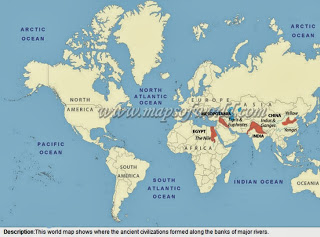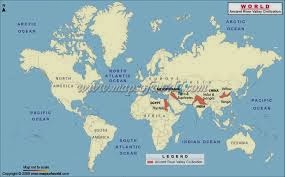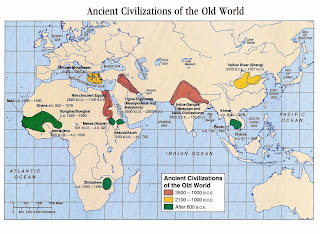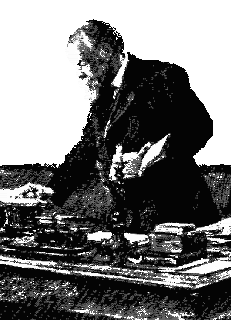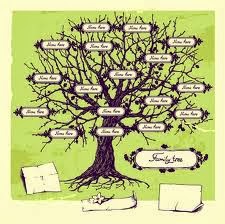Compared with a lion, a gorilla, or even a horse, the human animal is weak,
slow and defenseless. And yet homo sapiens has become the dominant species of
the planet. Our species developed none of the specialized attributes that have
fitted other creatures so well for their environments. Physiologically, we have
hardly evolved at all since we became a distinct species. Whereas other species
have evolved to fit their environments and the available food supplies, human
beings have remained unspecialised, but very adaptable. Instead of their bodies
altering to suit their environments, they have altered their environments to
suit themselves.
Human beings spread across the surface of the planet, occupying tropical rain
forests, deserts, temperate regions, and even polar ice. They lived on virtually
every type of food possible, from seal fat to tropical fruits and desert
insects. And from this variety of life-pattems there arose wide differences in
knowledge, beliefs, attitudes, feelings and behaviour. Almost every conceivable
kind of belief has been adopted by some humans at some time somewhere. Although
we are one species, from the jungle of New Guinea to the streets of New York,
the inhabitants of different places may think and act in quite dissimilar
ways
And yet a baby, carried across the world from New Guinea to New York and
brought up there, could become a complete New Yorker, with the accent, the food
preferences, the personal habits, the love of baseball, and the average tendency
towards obesity, heart disease, divorce and crime. The basic animal is the same,
but all behaviour patterns and ideas are shaped by the society in which the
child is brought up.
But if societies mould individuals, different types of society are themselves
shaped by a number of external factors, as well as by the activities of
individuals and classes within them. The basic needs of the human animal are,
like those of any other mammal, food, drink, warmth and sex. But these needs
have not always been easily met .For most of human existence, the lives of the
great majority have been dominated by scarcity. The methods of making a living
from the land and sea have therefore been the major influences on the sorts of
lives people have led, the types of society that have been formed, and the
attitudes and behaviour of those societies
We do not know exactly how long ago human beings evolved from other species.
Modern man, according to many anthropologists, emerged in Africa about 100,000
years ago, and gradually spread out from there to replace all earlier species in
the rest of the world (Snooks, 1996:50). For most of that time people lived
communally, through hunting and gathering. For many thousands of years there was
no private property, no money, no working for wages, no stock exchange and no
class divisions. People lived with and for one another. It was a system of
primitive communism.
The comic cartoon idea of the cave man with his club displaying aggression
towards everyone is a fiction. Such an individual would not have lasted a week
in the world of prehistory. Human beings have survived and prospered because
they are adaptable and they have co-operated with one another. Long before there
were private property societies with their class divisions and exploitation,
small hunter-gatherer communities relied for their existence on all members
playing their part. This co-operation lasted for many tens of thousands of
years. The remnants of it can still be seen in surviving primitive communities
such as of the Bushmen of the Kalahari Desert, the pygmies of the Congo rain
forests, Australian aborigines and South American Indians.
The earliest human societies -as self-sufficient producer groups -would have
been composed of relatively small numbers whose members survived in nature as
nomadic bands capturing and killing wild animals and gathering wild plants,
fruits and insects. The particular character of these material conditions of
production demanded a certain division of labour between hunters, gatherers and
those engaged in making the tools used in these activities. They also demanded
free access to nature, the main means of production
Thus, in accordance with the material conditions of production in which
hunter-gatherer societies operated, they were societies which did not know
private ownership of the means of production. There was no private ownership of
what was produced. What was produced -whether by hunting or gathering -was not
the private property of the hunter or the hunting party or of the gatherer(s)
but was to be shared out among all the members of the group on an equitable
basis. Hunting, gathering and tool-making were all regarded as essential
activities entitling those who performed them to be maintained by the whole
group.
It used to be thought that living by hunting and gathering was a bad way to
live. But recent evidence suggests that they lived in surprisingly abundant
environments that provided all of the basic calories, nutrients and proteins
they needed, and they worked relatively few hours to enjoy those things. This
left them plenty of free time for visiting relatives, playing games, or just
relaxing (Sanderson, 1995:21).
Anthropologists who live among the hunter-gatherers who survive today
describe the ways in -which they are generally free from material pressures.
According to Sahlins:
It is not that hunters and gatherers have curbed their materialistic
impulses; they simply never made an institution of them… We are inclined to
think of hunters and gatherers as poor because they don't have anything; perhaps
better to think of them as free. A good case can be made that hunters and
gatherers work less than we do; and, rather than a continuous travail, the food
quest is intermittent, leisure abundant, and there is a greater amount of sleep
in the daytime per capita per year than in any other condition of society
(1972:14)
Settled agriculture
The practice of settled agriculture represented a major change in the
material conditions of production. It meant an end to nomadism and the
establishment of settled communities. It also meant an increase in the amount of
food available, so permitting an increase in the size of human communities. But
it also involved a different division of labour which paved the way, as it
developed, for the emergence of minority control over access to the means of
production.
The first settled agricultural communities would have been established by
societies which had previously practised hunting and gathering and so had a
communistic economic structure. This was characterised by the absence of private
ownership of the means of production and by the sharing of products according to
need. After the adoption of agriculture, these communistic economic arrangements
survived for a while, but tended to break down in the long run as they no longer
corresponded to the material conditions of production.
The social arrangement for meeting the material requirements of early
agriculture is most likely to have been the allocation to family units of plots
of land to cultivate. This was not yet the establishment of private ownership,
but it meant the end of free access to the means of production that had obtained
in hunter-gatherer societies. It ruled out any member of society simply helping
themselves to the products of any plot of land. Normally they would only have
free access to the products of the plot cultivated by the family unit to which
they belonged.
Nevertheless, such a limitation is not incompatible with the continuation of
some communistic practices. The actual cultivators could still be regarded by
the community as performing a function on its behalf and be required by social
custom to contribute any surplus product to a common store on which any member
in need could draw. This could happen, for instance, as a result of their crops
having failed or been destroyed by a storm. Such social arrangements have been
discovered in societies at this stage of development which have survived into
modern times.
The existence of a common store becomes another aspect of the society's
material conditions of production and requires a social arrangement for managing
this store -collecting and distributing the surpluses. The usual arrangement
seems to have been to confer this responsibility on a particular family.
Arguments can go on as to whether being given this responsibility was conferred
on a family whose head had already acquired this status for other reasons
-perhaps military or religious. But the fact remains that this role of
collecting and redistributing surpluses had to be filled if all the members of
the community were able to meet their basic needs as of right.
The Emergence of Class Society
It is easy to imagine how over time the co-ordinating role in distribution
could become a source of privileged consumption for the chief and his family.
The duty to contribute any surplus products to the common storehouse could
become a duty to contribute this to the chief, and the chief and his family
could come to consume an excessive amount of the stores at the expense of
distributing them to those in need.
The tendency for what was originally a necessary technical function to evolve
into a social privilege would have been even more pronounced when the
co-ordinating role concerned production rather than simply distribution. It was
the case when large-scale irrigation works had to be managed so that agriculture
could be practised. For instance, this happened with agriculture in the Nile,
Euphrates and other river valleys. It was the main material condition of
production which gave rise to an economic structure in which the cultivators
were exploited by a class of priests who collectively controlled the key means
of production which the irrigation works represented.
The emergence of control over means of production by a section of society, or
social class, was a radical departure in human social arrangements. Production
was no longer controlled by society as a whole. Such societies ceased to be
communities with a common interest and became divided, with one class, on the
basis of its control over access to and use of the material forces of
production, exploiting the productive work of the other class and allocating
itself a privileged consumption.
The emergence of class and property meant that some humans acquired the power
to exclude others from access to the material forces of production, including
nature, except on their terms. In these circumstances, humans ceased to be a
united community seeking to satisfy the needs of all its members. Instead they
became members of a class-divided society in which there is internal conflict
over how the material forces of production and distribution should be used: to
satisfy the needs of all or to accumulate wealth for the few.
Throughout history this conflict has nearly always been settled in favour of
the class that has controlled the means of production. There are two main
reasons for this. First, the power of this class was based on a real functional
role within the division of labour, at least originally. Secondly, this class
controlled armed bodies to enforce its will, thus enabling it to hold on to
power, at least for a while, even after its original function in organising
production had disappeared and been taken over by some other group as a result
of technological change
The discovery and utilisation of metals, and the development of more and more
complex tools and machines have usually gone hand in hand with progress in
methods of making a living, increasing the amount of wealth produced per capita
many times over. But the benefits of these improvements have not been shared by
all members of society. After the rise of settled townships on an agricultural
base in Mesopotamia, trade between localities developed. For the first time the
products of hands and brains took on an alien life as commodities to be
bartered, and then bought and sold with the abstract commodity of money.
Property, realised at the boundary between tribes, began to impinge within them.
The first property society came to be developed when people were bought and sold
as slaves.
Slavery
Slavery differs fundamentally from wage labour. With the wage system the
labour power of the worker becomes one of the main commodities in the
marketplace. With slavery the workers themselves become commodities, they have
no rights and are legally the property of the person who controls them. Slaves
were fundamental to the economy of ancient Greece and Rome during their
classical periods -the fifth to third centuries BC for Greece and the first
century BC to the second century AD for Rome (Applebaum, 1992:170).
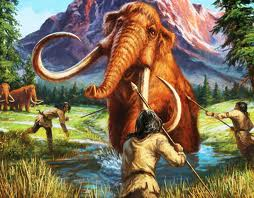
Anyone might have become a slave through capture in war, piracy, or breaking
the law. They could be bought or sold through the slave trade on the open
market. Slaves in theory had no rights. They were property and might be disposed
of as their masters wished. In practice, slaves did have some protection under
the law -the owner could not maltreat slaves or put them to death with
impunity.
Access to political power was unthinkable for slaves. The only form of action
they could take was running away when a favourable opportunity arose. However,
it cannot be assumed that all slaves occupied a low status in Greek and Roman
society, although undoubtedly most of them did. Slaves worked on farms, in
workshops and in mines, mostly under harsh conditions. But there were slaves
employed as managers and administrators, especially during the Roman Empire.
Slaves were also employed as professionals, teachers, doctors, and household
servants. Some slaves who were engaged in commerce even engaged their own
slaves.

Between 1500 and 1870 plantations in the southern USA, the Caribbean and
Brazil contained 10 million slaves (Wallace, 1990:71). Although it is mainly an
institution of the past, slavery or slave-like practices are still common around
the world (Levinson and Christensen, 1996:291). The three main forms are child
labour, debt bondage and forced labour. Around 100 million children world-wide
are forced to work long hours in unhealthy conditions and are paid little or
nothing for their labour. In India alone an estimated 6.5 million people have
pledged their labour against debts. Often the debt bondage (illegal since 1976)
remains so for life.
Feudalism
In the feudal system absolute ownership of the land is vested in the feudal
lord but, unlike the slave owner, his title to the worker (serf) is not
absolute. The lord owns him merely by title to a share of his labour. In return
he is obligated to grant the worker use of some land, some ownership of tools
and some of the products of his own labour. Slavery thus gave way to serfdom. In
both cases the majority was exploited by the minority. The slave owned none of
the products of his labour but was fed and clothed by his owner. The serf had
enough to keep himself and his family alive, but the rest was appropriated by
the lord, a non-producer (Venable, 1945:100).
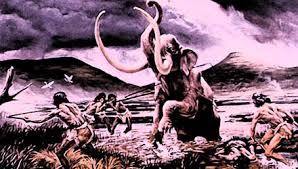
Feudalism evolved as a hierarchical system of personal relationships in which
land and military power—and of course the labour of the serfs—were the principal
commodities exchanged. (Singman 1999:4). The system was strengthened and
expanded in Britain with the eleventh-century Norman Conquest. In feudal times
the king nominally owned all the land. He granted lands to his tenants-in-chief,
the aristocracy, and they in return had to give military service to him and pay
customary dues which comprised a percentage of their wealth. Not only did the
feudal aristocracy and the church own most of the land, but they controlled the
men and women who lived and worked on it. The landlords had their own courts,
they levied taxes and exacted services from their serfs and, in times of war,
they ordered their subjects to fight their battles.
The power of the feudal lord depended on the amount of land he owned and the
number of peasants he could control. Peasants had feudal obligations to their
landlord. They either had to work on his land for a certain length of time each
week or else they had to give him a portion of their produce in return for
living on his land. Either way, the landlord received his wealth without having
to work.
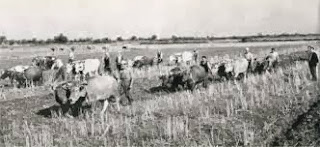
Every family had access to a piece of land for cultivation and to the commons
for pasturing their animals. Their rights were recognised by all. The behaviour
which regulated society was not backed by sanctions -law, police or army -but by
custom which was a condition of existence: expulsion from the community could
mean death from hunger or exposure (Smith, 1994:58).
Capitalist social relations emerged with the expropriation of common land by
the aristocracy in the fifteenth and sixteenth centuries. The lands were
enclosed to be used for sheep farming rather than arable cultivation. One reason
for this was that the new Flemish woollen industry made sheep more profitable
tenants than peasants. Enclosure destroyed the lives of thousands of peasant
families, turning them into propertyless vagabonds. In dealing with the
primitive accumulation of capital, Marx wrote:
The fathers of the present working class were chastised for their enforced
transformation into vagabonds and paupers. Legislation treated them as voluntary
criminals and assumed that it depended on their own good will to go on working
under the old conditions that no longer existed (1954, vol. 1 :686).




